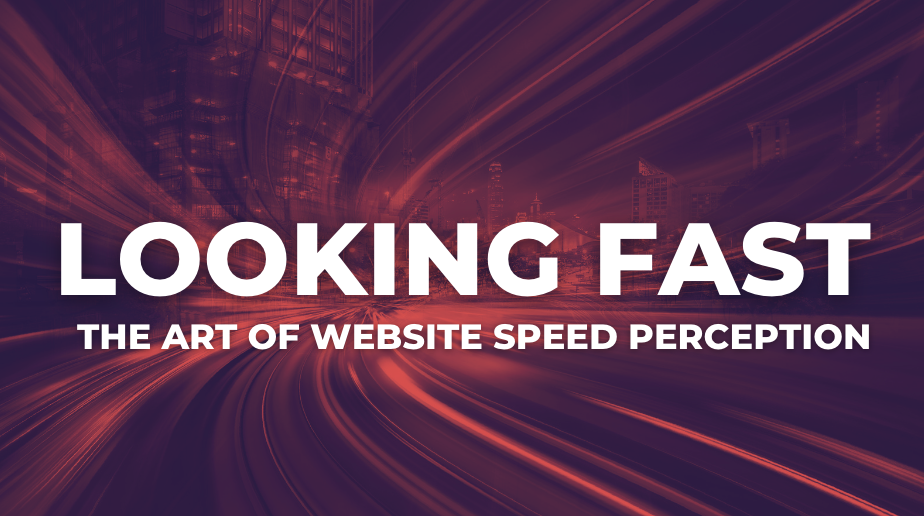Much has been said about optimizing the technical aspects of your site to ensure it loads fast, but what about a less discussed, yet equally vital aspect; “looking” fast? Let’s take a look at perception and explore how subtle design choices can enhance the user experience, leading to higher conversions.
The Need for Speed
Speed is of the essence in today’s mobile web. We all know that a website that loads faster can significantly impact user engagement and, subsequently, conversions. When your website is nimble and responsive, it fosters a sense of efficiency and professionalism. Visitors are more likely to stay, explore, and take the desired actions.
However, website speed isn’t always only about technical optimization. It’s also about the way your website “feels” to your visitors. Here’s where the art of “website speed perception” comes into play.
Mozilla Developer Source has this to say about Perceived speed & peformance:
Perceived performance is a subjective measure of website performance, responsiveness, and reliability. In other words, how fast a website seems to the user. It is harder to quantify and measure than the actual speed of operation, but perhaps even more important.
Think with Google has this to say:
New research shows that while speed definitely matters on the mobile web, user perceptions of speed can be just as important – presenting site owners with a range of additional approaches for improving usability.
The Design Details
Consider the design of your website, specifically the layout and the visual cues that guide a user’s journey. For instance, the alignment of form fields can influence how fast users perceive the process of filling them out. Horizontal and vertical alignments may create different perceptions of ease and speed. Experiment with various layouts to see which one resonates with your target audience.
Harnessing Animation
Animation is another powerful tool for creating the illusion of speed. Well-executed animations can make interactions feel effortless and quick. When elements smoothly transition or react to user actions, it conveys a sense of fluidity and speed. Animation can be particularly effective when applied to your main call to action, as it draws immediate attention and encourages quick responses.
The Power of Perception
The perception of speed can often be more important than actual load times. When users quickly notice and engage with your call to action, it feels like a swift and seamless experience, even if the technical metrics suggest otherwise. This psychological aspect of speed is something every web designer and marketer should harness.
Designing for Speed Perception
As you embark on your next web design project, consider the following tips to optimize speed perception:
1. Prioritize User-Centric Design
Put yourself in your users’ shoes. Understand their expectations and preferences. A user-centric design approach ensures that your website caters to their needs and leaves a positive impression of speed.
2. Streamline Navigation
Clear and intuitive navigation is crucial for a fast-paced user experience. Implement straightforward menus, logical page structures, and quick access to essential information.
3. Optimize Mobile Responsiveness
With the majority of internet traffic coming from mobile devices, mobile optimization is paramount. Ensure your website is responsive and delivers a seamless experience on all screen sizes.
4. A/B Testing
Experiment with different design elements and layouts through A/B testing. This data-driven approach allows you to refine your website’s design based on user preferences and perceptions of speed.
5. Utilize Analytics
Leverage web analytics tools to gain insights into user behavior. Identify any bottlenecks in your website’s user flow and address them promptly to enhance the perception of speed.
6. Consistency Is Key
Maintain a consistent design and user experience throughout your website. Familiarity breeds comfort, and a consistent layout and design will make users feel more at ease and perceive your site as faster.
Wrap Up
In the world of website speed, both the technical side and how users perceive speed are important. Technical aspects ensure your site works well, but how users feel about its speed is equally crucial. By making design choices that enhance the user experience, you can boost conversions and surpass your digital competitors. So, when you’re working on your next web design project, remember that the way your site appears to users can make a big difference. It’s not just about speed; it’s about looking fast, which can give you an edge in the competitive online world.
Further reading and study
How Do People Perceive A Website’s Speed?
The psychology of web performance
Perceived vs. Actual Loading Time: Create the Impression of a Fast Website






0 Comments